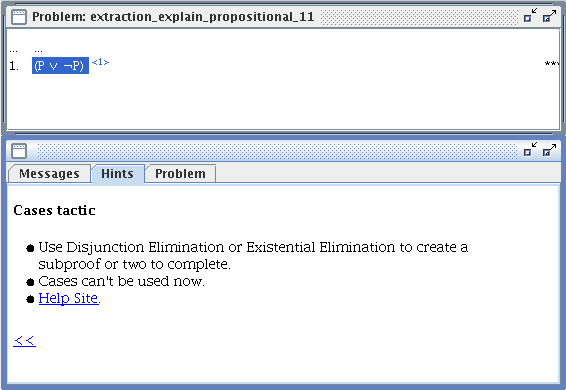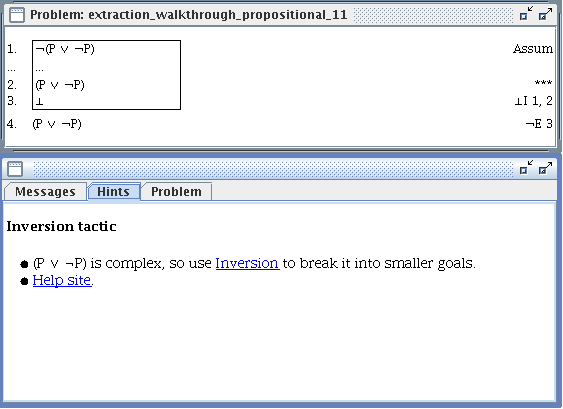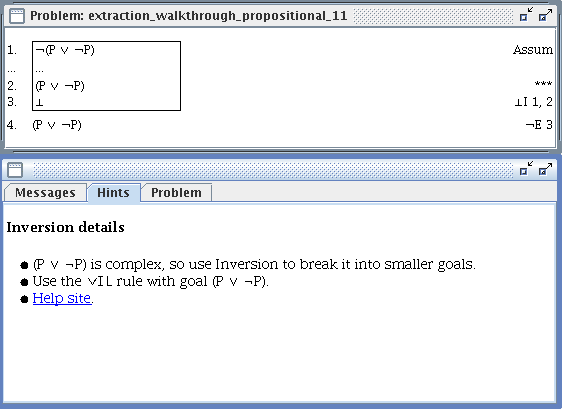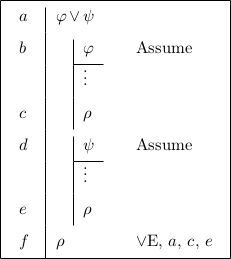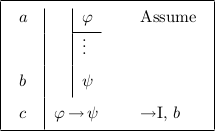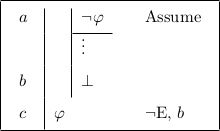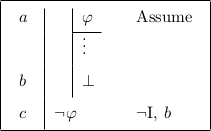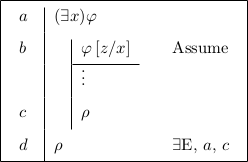Chapter 1 Background
For our project it was crucial to have a “theorem proving system” that can provide advice to a student user; indeed, pertinent advice at any point in an attempt to solve a proof construction problem. To be adequate for this task a system must be able to find proofs, if they exist, and follow a strategy that in its broad direction is logically motivated, humanly understandable, and memorable. [Sieg and Scheines, 1992]
Logic and Proofs is an introduction to formal logic. This online course provides a proof construction environment. AProS, an automated theorem prover, provides the basis for automated dynamic hint generation as part of the proof construction process. The core of my work, then, is putting these two components together in a sensible and effective fashion, providing a demonstration of how one can harness an expert system in order to provide automated tutoring as well as a useful addition to education software that is and will continue to be used by students every semester.
1.0.1 Acknowledgments
Some of the ideas here go back a long time; the first papers on the topic were written by Sieg and Scheines; e.g., Sieg and Scheines [1992, pp. 154]. I make extensive use of AProS, written in large part by Joe Ramsey, and later rewritten by Tyler Gibson. When I needed new features or changes to AProS and the Carnegie Proof Lab, Tyler Gibson and Davin Lafon provided a great deal of assistance. The technical groundwork for implementation of the tutor was laid by Jesse Berkelhammer and Davin Lafon. Producing a good tutor involved discussions with many of the aforementioned individuals, as well as Marjorie Carlson, Iliano Cervesato, Akiva Leffert, Jason C. Reed, and Paul Zagieboylo. Finally, the entire project exists because of Sieg, who has kept me moving in the right direction.
1.1 An overview of the Logic and Proofs course
Logic and Proofs [Open Learning Initiative website, AProS website] is an online logic course, developed at Carnegie Mellon University (CMU) since 2003. The course covers propositional and first-order logic, motivating each of these with natural language examples of arguments captured in said logics. The online text is composed of HTML with graphics, Flash videos [Flash website] and exercises. Each Flash exercise is designed either to elucidate a restatement1 — or make use2 — of a recently presented concept. It also makes use of the Carnegie Proof Lab (CPL), a natural deduction problem solving environment.
1.1.1 History of the Logic and Proofs course
In the early nineties, the Carnegie Proof Tutor project [Sieg and Scheines, 1992, pp. 154] explored the effects of different computer-based proof construction environments. At that time, Sieg was also developing the intercalation calculus, a formalization similar in character to the sequent calculus, to enable automated proof search in natural deduction. In the latter half of the decade, the intercalation calculus was extended from propositional to first-order logic [Sieg and Byrnes, 1998]. AProS, short for “automated proof search”, is an automated theorem prover that makes use of the intercalation calculus in proof search. The Logic and Proofs project began in 2003. On one side it involved developing an online logic course, complete with the Carnegie Proof Lab, a natural deduction proof construction environment. On the other side, it involved implementing AProS in Java. In 2003 and until recently, some of the libraries in AProS were shared with the Carnegie Proof Lab, but this was the extent of the overlap. While the Carnegie Proof Tutor does contain “tutor” in the title, it is only recently that we have implemented tutoring in the Carnegie Proof Lab, and in this way AProS and the Carnegie Proof Lab have been brought closer together [Sieg, 2007].
1.1.2 Course structure
The online Logic and Proofs material can be used in various ways: as a completely online course that meets only for exams, as a course that meets once a week (as done at CMU), as a course meeting two or three times a week with the online text used instead of a paper textbook, or some variation on the above. The online material is organized and presented in a fashion designed to lessen the need for lectures, so instructors can use class time for review, group work, student presentations, or other non-lecture activities. As offered at CMU, Logic and Proofs is a general elective with no prerequisites. The class has thirteen chapters — an introductory chapter on statements and arguments is followed by six chapters for propositional logic and six more for first-order logic. Chapters are typically completed weekly. In each section, there are chapters devoted to motivation and syntax of the language, chapters devoted to semantics and finding counterexamples with truth trees, and four chapters involving proofs. By the end of five chapters (five weeks, then), students are expected to be able to produce reasonably complex and long proofs3 in propositional logic. The basic rules of propositional and first-order logic have their respective chapters, as do derived rules and strategies. Other major topics include metamathematics and Aristotelian logic. There are homework assignments at the end of each chapter as well as Learn by Doing exercises, either in Flash or using the Carnegie Proof Lab.
1.2 Formal Logic
Logic and Proofs covers natural deduction proofs in classical sentential and first-order logic. I use fairly standard formal logic notation, but because notation often varies in subtle and important ways, it is worth reviewing.
- Propositional formulas
- Atomic formulas are upper-case letters A, B, . . . , Z. Compound formulas are produced recursively. Given any two formulas ϕ and ψ, there are compound formulas ¬ϕ, (ϕ & ψ), (ϕ ∨ ψ), (ϕ → ψ), and (ϕ ↔ ψ). A contradiction is represented by the falsum, ⊥. Logic and Proofs diverges from the presentation in Sieg and Byrnes [1998] in that ⊥ is used to represent a contradiction and is often used in place of the contradiction itself. However, ⊥ is a special formula in the language4, and can only be used as noted.
- Variables for propositional formulas
- Variables that range over formulas are lower-case Greek letters — typically, ϕ, ψ, and ρ. Unless explicitly stated, variables do not represent ⊥; one should use ⊥ itself as needed.
- Quantifiers
- Lower-case letters a, b, . . . , z are terms. There are two types of terms: constants, a, b, . . . , s, and variables, u, v, . . . , z. For convenience, we reserve t for terms that could be constants or variables. Given any formula ϕ and any variable x, one can form the first-order compound formulas (∀x)ϕ and (∃x)ϕ. If an instance variable is not quantified in a formula ϕ, it is free in ϕ; otherwise, it is bound. The rules for producing compound formulas in propositional logic also apply in first-order logic.
- Predicates
- Upper-case letters A, B, . . . , Z followed by parentheses containing zero or more terms are predicates. Zero-place predicates behave just like propositional atomic formulas, and I often drop the parentheses after such predicates.
- Subformulas
- For any formula ϕ, ϕ is a subformula of ϕ. For any formula ρ of form (ϕ & ψ), (ϕ ∨ ψ), (ϕ → ψ), or (ϕ ↔ ψ), ϕ and ψ are subformulas of ρ. ϕ is a subformula of ¬ϕ. As for first-order logic, ϕ with all free instances of x replaced by any term t is a subformula of (∀x)ϕ and (∃x)ϕ for any variable x. As well as being reflexive, the subformula property is transitive; that is, if ϕ is a subformula of ψ and ψ is a subformula of ρ, then ϕ is a subformula of ρ. Another useful notion is that of a strictly positively embedded subformula. Strictly positively embedded subformulas are defined just like subformulas with the following exceptions: for any formulas ϕ and ψ, ϕ is not a positively embedded subformula of ¬ϕ or (ϕ → ψ). If ϕ is a positively embedded subformula of ψ, we say ϕ is positively embedded in ψ. A positively embedded subformula that is a negation is called a positively embedded negation. Let ϕ ◁ ψ mean that ϕ is a positively embedded subformula of ψ.
- Variables for first-order formulas
- Variables for first-order logic are similar to those for propositional logic. Lower-case Greek letters are used, and the interior of a predicate is expounded as necessary. For example, ϕ (a, b, c) can represent A (a, b, c) or E (a, b, c) but not A (b, c). If the interior of the predicate is irrelevant, the formula may be represented as just ϕ.
For the above syntactic objects, if one is running low on them, one can subscript them with natural numbers — that is, x0, ϕ100, and similar syntactic objects are permissible. In Logic and Proofs, the material is divided strictly into propositional and first-order sections, so terms, predicates, and quantifiers are all introduced at roughly the same time.
1.2.1 Natural deduction proofs
A proof is a finite sequence of formulas with several constraints. The first zero or more formulas are the premises, and the last formula is the goal. Each formula has a corresponding justification, where a justification could be that the formula is a premise, assumption, or the result of an inference rule; these are described in the next section. Additionally, every formula is in a subproof, which is determined by the set of premises and assumptions upon which the formula relies. For a proof or partial proof, let us define the assertion as the original premises and conclusion of it. Logic and Proofs uses Fitch diagrams5 to present proofs. When constructing proofs, Fitch diagrams have some advantages over Gentzen’s tree notation, but because the recursive construction of a tree is easier to describe than that of a Fitch diagram and many properties of proofs are described recursively, tree proofs are often easier to use and understand when describing properties of proofs. Converting to and from a Fitch diagram to a tree proof is conceptually easy, so I switch notation as clarity dictates.
In Logic and Proofs, students bridge the gap from the premises of an argument to its conclusion using inference rules6. The two big questions, closely connected, are “what inference rules can be applied right now?” and, given that list, “how shall I decide the order in which to try them?”. The latter question is addressed in Section 1.2.3; as for the former — close in keeping with the presentations in Gentzen [1969] and Prawitz [1965], Logic and Proofs has the following basic rules: Conjunction Elimination Left (&EL), Conjunction Elimination Right (&ER), Conjunction Introduction (&I), Disjunction Elimination (∨E), Disjunction Introduction Left (∨IL), Disjunction Introduction Right (∨IR), Implication Elimination (→E), Implication Introduction (→I), Negation Introduction (¬I), Negation Elimination (¬E), and Falsum Introduction (⊥I)7. By replacing Negation Elimination with ex falso quodlibet, intuitionistic logic is obtained8. By adding Universal Elimination (∀E), Universal Introduction (∀I), Existential Elimination (∃E), and Existential Introduction (∃I), first-order logic is obtained. See Appendix A for precise formulations of the inference rules. Each of the above rules is classified either as an elimination rule or an introduction rule by its name, except that Negation Elimination is an introduction rule and Falsum Introduction is an elimination rule. Also, the above rules can be used from the premises working towards the goal (forwards), from the goal working towards the premises (backwards), and working directly from both the premises and the goal (forwards-backwards). An example of a forwards move is found in Table 1.1.
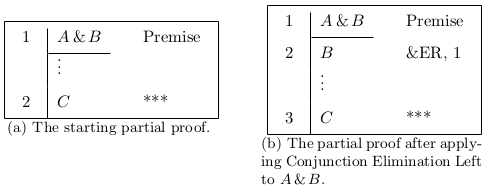
Figure 1.1: An example of a forwards move.
Because forwards moves are dependent only upon the premises or assumptions used in the rule, it is easy to use forwards rules that produce unwanted or unneeded lines in a partial proof. One can work backwards from a goal, so we mark open questions — that is, goals not yet proven — with *** to the right. A completed proof is one with no open questions; a partial proof, by contrast, is one with at least one open question. An example of a backwards move is found in Figure 1.2.
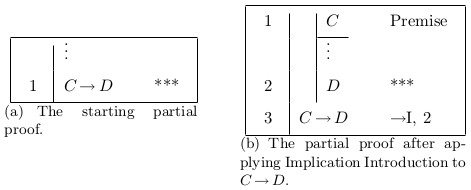
Figure 1.2: An example of a backwards move.
Because backwards moves are fairly well determined, except for Disjunction Introduction Left and Disjunction Introduction Right, there is little ambiguity in determining which rule to use. Forwards-backwards moves involve selecting a premise and a goal. Application of the rule produces one or two subproofs with an assumption and goal in each. These rules are sometimes called closed scope elimination rules or simply closed scope eliminations, and the conclusion of such a rule may have no syntactic connection with the premise. An example of a forwards-backwards move is found in Figure 1.3.
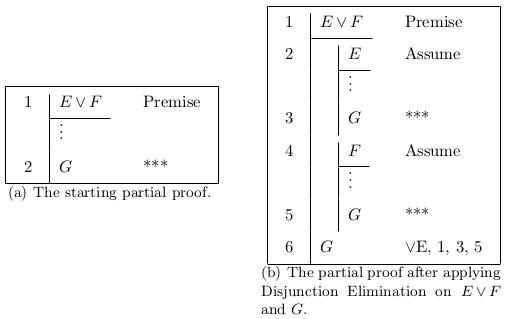
Figure 1.3: An example of a forwards-backwards move.
A proof or partial proof is p-normal if no formula occurrence in it is the major premise of an elimination rule as well as the conclusion of either an introduction rule or Negation Elimination [Sieg and Byrnes, 1998, pp. 68]. In a small shift9 from Sieg and Byrnes, I define the adjacency condition as follows. The adjacency condition is satisfied so long as there there is no rule application of Falsum Introduction such that either the major premise of that application is the conclusion of Negation Introduction or Negation Elimination10. See Figure 1.4 for examples of non-normal proofs.

Figure 1.4: Non-normal proofs.
If a proof or partial proof is p-normal and satisfies the adjacency condition, it is by definition normal; this is equivalent to Prawitz’s definition [Sieg and Byrnes, 1998, pp. 68]. As discussed later, non-normal proofs and partial proofs can be undesirable in proof construction; see also Prawitz [1965] and Sieg and Byrnes [1998].
1.2.2 The intercalation calculus
. . . there was one question that disturbed [the student] again and again: “Yes, the solution seems to work, it appears to be correct; but how is it possible to invent such a solution? . . . and how could I invent or discover such things by myself?” [Polya, 1945].
In order to shrink the search space and avoid detours in natural deduction proof construction, rule use can be restricted, either formally, by not allowing undesirable moves, or informally, by recommending only desirable moves. To this end, we reexamine the intercalation calculus, a modification of the sequent calculus that more cleanly captures proof search in natural deduction. This presentation is similar to Sieg [2005], Sieg and Byrnes [1998], Sieg [1992], and Sieg and Scheines [1992], except that it is more restrictive. Here we want to use the intercalation calculus in a limited way — to capture a particular strategic approach to proof search and construction which will be discussed in Section 1.2.3. Consequently, we formulate the inference rules to directly mirror this approach.
The intercalation calculus11 can be formulated in production rules that operate over triples of the form Γ ; n ◀ ϕ ? G or Γ ; · ? G, shown below. Γ is the set of premise and assumption formulas, G is the goal formula, and n ◀ ϕ is an extraction — an occurrence of the goal, n, strictly positively embedded in ϕ. Let · denote the empty extraction. We call the triple on the right of the ⟼ the premise of the rule and the triple on the left the result of the rule. The intercalation calculus rules are expressed as rewrite rules; we start with the ↑ and ¬ rules.
| &↑ | Γ ; · ? (ϕ & ψ) | ⟼ | Γ ; · ? ϕ and Γ ; · ? ψ. |
|---|---|---|---|
| ∨i↑ | Γ ; · ? (ϕ1 ∨ ϕ2) | ⟼ | Γ ; · ? ϕi for i = 1 or i = 2. |
| →↑ | Γ ; · ? (ϕ → ψ) | ⟼ | Γ ∪ {ϕ} ; · ? ψ. |
| ¬↑ | Γ ; · ? ¬G | ⟼ | Γ ∪ {G} ; · ? ⊥ |
| ¬C | Γ ; · ? G | ⟼ | Γ ∪ {¬G} ; · ? ⊥. |
| ⊥(𝓕) | Γ ; · ? ⊥, ϕ ∈ 𝓕(Γ) | ⟼ | Γ ; · ? ϕ and Γ ; · ? ¬ϕ |
| ∨⇂∗ | Γ ; · ? G and (ϕ ∨ ψ) ∈ Γ | ⟼ | Γ ∪ {ϕ} ; · ? G and Γ ∪ {ψ} ; · ? G. |
For ⊥(𝓕), let 𝓕(Γ) denote the set of unnegated formulas whose negations are positively embedded subformulas in Γ. ¬C may not be used when the goal is ⊥. To start using ↓ rules, the goal must be positively embedded in a premise or assumption — this is specified by n in n ◀ ϕ. While ◁ is used for strictly positive subformulas, ◀ is used for strictly positive subformula occurrences, so n ◀ ϕ is more restrictive than n ◁ ϕ. Only the ↓ rules can be used on triples with non-empty extractions. To stop using the ↓ rules, n must be obtained. Because n is a particular instance of G, the exact sequence of ↓ rules is determined when the first one is applied. This corresponds to a partial natural deduction proof where one notes that the goal is positively embedded in a premise or assumption and uses elimination rules to get to the goal.
| E↓ | Γ ; · ? G and ϕ ∈ Γ and n is an instance of G and n ◀ ϕ | ⟼ | Γ ; n ◀ ϕ ? G. |
|---|---|---|---|
| &i↓ | Γ ; n ◀ (ϕ1 & ϕ2) ? G | ⟼ | Γ ; n ◀ ϕi ? G for i = 1 or i = 2. |
| →↓ | Γ ; n ◀ (ϕ → ψ) ? G | ⟼ | Γ ; · ? ϕ and Γ ; n ◀ ψ ? G. |
| ∨i↓ | Γ ; n ◀ (ϕ1 ∨ ϕ2) ? G | ⟼ | Γ ∪ {ϕi} ; · ? G and Γ ∪ {ϕj} ; n ◀ ϕj ? G for i ≠ j. |
For completeness, though, we cannot only consider eliminating disjunctions in Γ — we must also consider disjunctions that are strictly positively embedded in formulas in Γ. The following inference rule, ∨⇂, is a generalized version of disjunction elimination — ∨⇂∗ is a special case of ∨ when the disjunction is in Γ, so ∨⇂∗ can be removed from any further considerations.
| ∨⇂ | Γ ; · ? G and ρ ∈ Γ and n is an instance of (ϕ ∨ ψ) and n ◀ ρ | ⟼ | Γ ; n ◀ ρ ? (ϕ ∨ ψ) and Γ ∪ {ϕ} ; · ? G and Γ ∪ {ψ} ; · ? G. |
|---|
Given a goal G and a set of premises, Γ, we can produce the search space for an intercalation calculus proof of the possibly-true assertion Γ ⊢ G. Start with Γ ; · ? G and do the following recursively. For each rule that could be applied to the current node Γc ; nc ◀ ϕc ? Gc, so long as it would not violate the adjacency condition and would not be a repeated question12, make a branch above it to each premise, Γn ; nn ◀ ϕn ? Gn, and then visit that premise. For an example of an intercalation calculus tree, consider tertium non datur.

The root is fully expanded, with branches for ∨1↑, ∨2↑, and ¬C. Each of these nodes, however, has not yet been expanded — ¬C could be used on all three13, ¬↑ could be used on the middle, and ⊥(F ) could be used on the right. Once such a tree has been fully expanded, it can easily be evaluated. For any leaf Γ ; n ◀ ϕ ? G, the leaf is marked Y if G ∈ Γ or G equals ϕ, and it is marked N otherwise. Starting from the leaves, the tree is evaluated14 recursively down to the root, where each node is marked Y if the dependency or dependencies of at least one of the rules producing a node above it is satisfied, and N otherwise15. If the root is marked Y, the argument is provable, otherwise it is not. When used in this fashion in proof search, the intercalation calculus with the above algorithm provides a complete search procedure, and it will provide only normal proofs. In practice, it may not be necessary to produce the entire search space tree if the root can be marked Y without doing so. Because of the correspondence between intercalation calculus rules and natural deduction inference rules, a search space tree with the root marked Y — a tree for a theorem — readily provides a natural deduction proof. To obtain one of these proofs — there may be several — work from the root upwards. From the current node, select one rule application that is marked Y. Retain it and then traverse its children, repeating as necessary. This produces a smaller tree from which, by retaining just the goal and mapping the rules in the obvious fashion, a natural deduction proof is obtained.
1.2.3 Strategic proof search in natural deduction
We define the four following tactics for proof search in natural deduction.
- Extraction
- Use one or more forwards elimination rules from a premise or assumption towards a goal. This corresponds to using the ↓ intercalation calculus rules.
- Inversion
- Use a backwards introduction rule on a complex goal. This corresponds to using the ↑ intercalation calculus rules.
- Cases
- Use Disjunction Elimination from a premise, assumption, or a disjunction strictly positively embedded in a premise or assumption16 to a goal. This corresponds to using the ∨ intercalation calculus rule.
- Refutation
- Use Negation Elimination on a goal. This corresponds to using the ¬C intercalation calculus rule.
Strategic proof search says to try the above tactics generally in the listed order, skipping tactics that would lead to partial proofs that violate the adjacency condition or repeated questions. This, then, is a heuristic or rule for deciding what branch of the intercalation calculus search space to pursue first. If the entire search space has been traversed and no proof is found, the argument is invalid. For some invalid arguments in first-order logic, this may not happen in finite time. In automated proof search, the strategic approach has various strengths. First, the proofs for which it searches have the subformula property, which places bounds on the search space. Second, extraction rules are restricted and only used when the goal is obtainable from the premise [Sieg and Scheines, 1992]. In some circumstances, this can noticeably speed up the search process [Sieg and Field, 2005]. Strategic proof search is useful for both humans and computers engaged in proof search. For computers, applying the tactics in order provides a search algorithm for traversing the search space, expressed by the AProS proof generator [AProS website]. For humans engaged in proof search, the strategic approach can also be used as an algorithmic proof construction procedure. Students first learning how to construct natural deduction proofs can have difficulty determining how to proceed, so having a procedure for completing a proof can be useful — classroom observation suggests that even students with some experience can have difficulty proving tertium non datur, ⊢ ϕ ∨ ¬ϕ, DeMorgan’s Law, ¬(ϕ & ψ) ⊢ ¬ϕ ∨ ¬ψ, and Peirce’s Law, ⊢ ((ϕ → ψ) → ϕ) → ϕ. The strategy may also be used as a valuable heuristic, in the Polyaic sense of the term [Polya, 1945]. Much of the time, students look at the section of a partial proof and see immediately how to finish it. In that case, there is no need to explicitly follow the algorithm. On the other hand, students often do not know what to try next or are in a state where they need to backtrack. Thinking strategically can help them properly determine what actions they might want to take or how much they need to backtrack.
1.2.4 The extraction rule
Inversion, cases, and refutation all require exactly one rule application to use, but extraction requires one or more rule applications, making the tactic harder to learn and use. To make the extraction tactic easier to use in the Carnegie Proof Lab, I introduce the extraction inference rule. To use an extraction, select a premise and a goal that is positively embedded in the premise. Applying the rule will use all of the elimination rules necessary to get to the goal. For each rule application that has a minor premise ϕ, ϕ is added to the partial proof as an open question. See Figure 1.5 and 1.6 for examples of extraction.
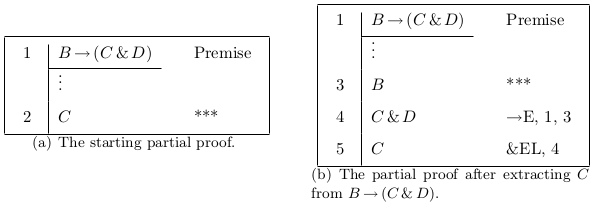
Figure 1.5: Using the extraction rule.
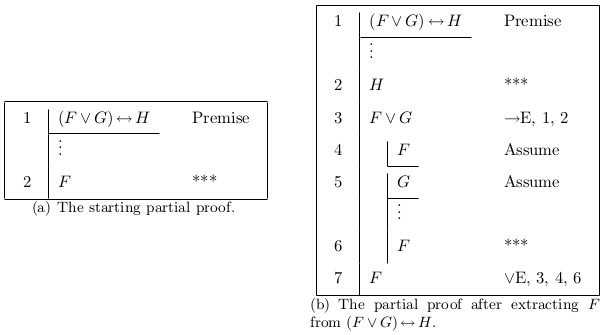
Figure 1.6: Using the extraction rule.
1.3 AProS: The Proof Generator
The AProS Proof Generator is an automated theorem prover that finds proofs in propositional and first-order logic [AProS website]. Making use of the intercalation calculus [Sieg, 1992, Sieg and Scheines, 1992, Sieg and Byrnes, 1998], its search style employs the previously-mentioned strategic proof search17. While the proof generator can be accessed independently through the Proof Display [AProS website], it can also be used by other programs as a library capable of producing strategically generated proofs. There are various ways in which the proof generator improves upon the basic strategic proof search; I note several here. For propositional logic these include: positive caching, negative caching, and careful selection of contradictory pairs. None of these improvements deviates from the aforementioned strategy. For first-order logic, the proof generator takes on a greater burden: it uses Skolem-Herbrand functions [Sieg and Byrnes, 1998, Enderton, 2001]. Also, it uses iterative deepening [Luger, 1997, pp. 106] to postpone traversing deep branches in the search space.
1.3.1 How to produce a tactical proof tree
We want to produce a tactical tree where each node 〈ϕ, t〉 has a formula (the goal of the rule application) and a tactic, and above each node are the open questions upon which that node depends. Given a natural deduction proof — obtainable from an intercalation calculus tree as mentioned in Section 1.2.2 — this is a straightforward recursive procedure starting from the goal and working upwards. For each non-extraction (non-↓) rule application, the goal is known and the above description of the tactics explains which tactic was used. The open questions are simply the premises of the intercalation calculus inference rule used in that step. For extraction moves (↓ rules) done in sequence, only one node is created, where ϕ is the goal of the bottommost extraction move and the open questions are the non-extraction dependencies of the rule applications in the sequence.
When this process is complete, the newly produced tree directly reflects the strategic moves used in the proof. Indeed, a preorder traversal18 of the tree gives a convenient step-by-step proof construction. When obtaining a proof from the proof generator, it is useful for the generator to retain some basic tactical information. In particular, extraction information is tedious to calculate after the fact. All of the other tactics are single rule applications, so one can determine their use simply by examining the current goal and the rule application associated with it. Regardless of how it is produced, a tactical tree is just what is needed to express AProS’s — or a student’s — moves in a strategic proof search.
1.4 The Carnegie Proof Lab
The design of the CPT was based on the belief that students learn more from exercises when their problem solving environment has three features. First, its interface must relieve the student of nonessential cognitive load. Second, it must allow students maximal flexibility in traversing the problem space. Third, it must provide locally appropriate strategic guidance. [Scheines and Sieg, 1994]
The Carnegie Proof Lab is a graphical proof construction environment. Written in Java, it is a multi-platform applet that is embedded into the Logic and Proofs course. The goal of the Carnegie Proof Lab is to make it easier for students to learn how to construct natural deduction proofs, and, once they can construct them, to prove harder problems with greater ease than on paper. See Figure 1.7 for a screenshot of the Carnegie Proof Lab.
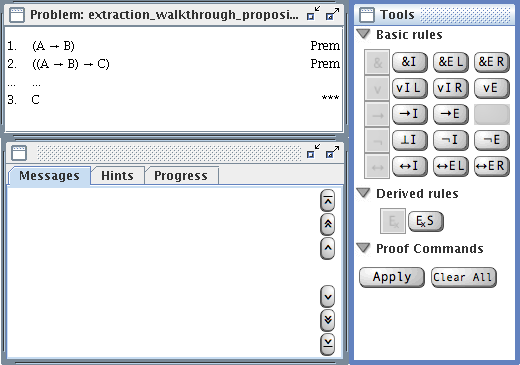
Figure 1.7: The Carnegie Proof Lab.
There are several components to the Carnegie Proof Lab: the partial or complete proof, the rule palette, and the message display. A problem is complete when there are no open questions left in the proof. To use an inference rule, students select the goal and premises necessary for the inference rule and click the “apply” button. A major strength of the Carnegie Proof Lab is that it minimizes the load on working memory, so that the student may focus on the relevant information; see Anderson et al. [1995, pp. 180] for more on working memory constraints.
As students progress in the course, they are exposed to more inference rules. The full set of inference rules for propositional logic, seen in Figure 1.8, incrementally become available to the student during the semester; these are progressively displayed in the Carnegie Proof Lab.
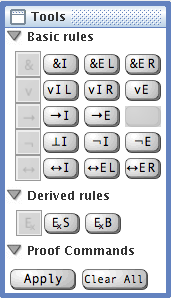
Figure 1.8: The inference rule palette.
Additionally, students may optionally view the form of the rule — that is, the outlines shown in Appendix A — when determining what inference rule to apply. When students make errors using inference rules, they receive feedback on the nature of the error. See Figure 1.9 for an error where only one premise is selected for Conjunction Introduction.

Figure 1.9: A sample error message.
Specifically, an error is an attempted use of an inference rule in a manner not specified — for example, providing only one premise to Conjunction Introduction19. Using an inference rule that does not lead towards a completed proof does not produce an error message. According to Gilmore [1996, pp. 120], “the emphasis is not on how well the user achieves the current task goals, but on how well he or she learns about the nature of the task in some general abstract way”. It can be instructive, then, to allow students to use inference rules in valid but unproductive ways — indeed, a main point of strategic proof search is to provide students a means of identifying good rule applications, so it could be counterproductive to flag them as errors here.
In accordance with Gilmore [1996, pp. 131], this proof construction environment is designed to foster planning moves. Students select premises and choose inference rules without having to actually apply the rule until they are ready. The rule forms can be examined, so students may select the appropriate rule for the occasion. Indeed, the environment is designed to be transparent to the extent that students may modify the partial proof by properly using inference rules as they desire. This allows students to focus on how to connect the premises with the conclusion.


